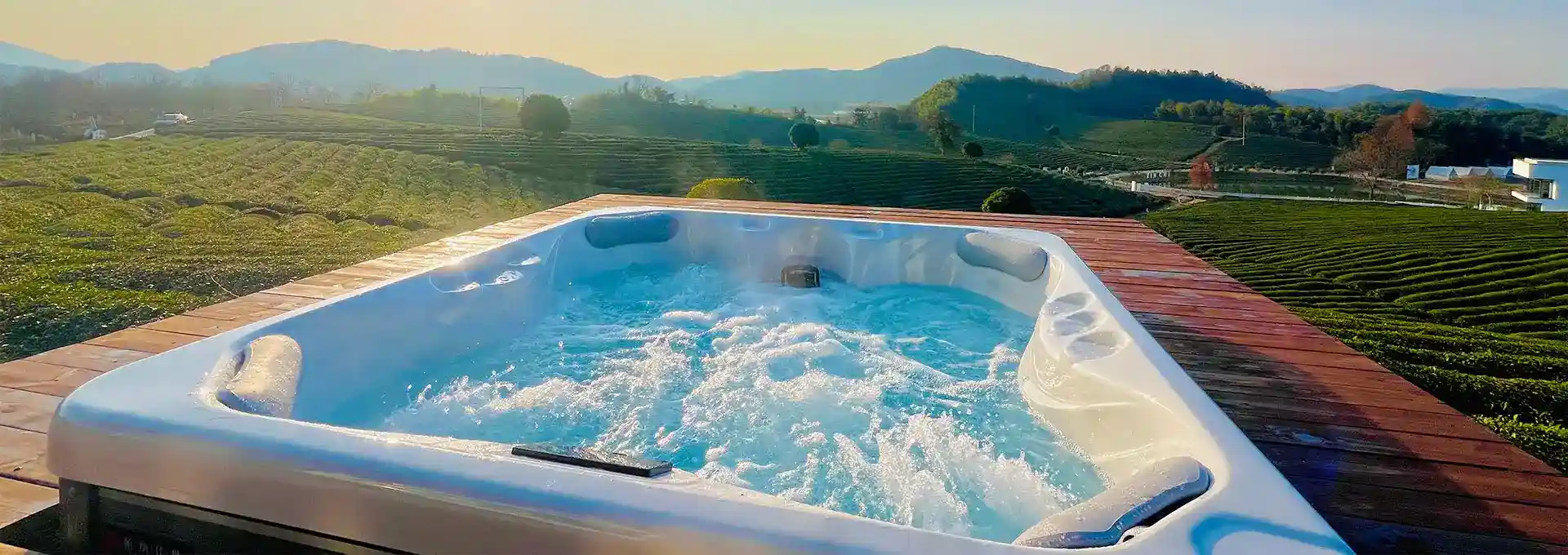Can I Move My Own Swim Spa?
2024-10-16 16:31:21
Swim spas have become increasingly popular among homeowners looking for a versatile aquatic fitness and relaxation solution. These compact pools offer the benefits of both a swimming pool and a hot tub in a single, space-efficient unit. However, one question that often arises is whether it's possible to move a swim spa once it's been installed. The short answer is yes, you can move your own swim spa, but it's a complex process that requires careful planning and execution.
Moving an inground swim spa is not a task to be taken lightly. These units are large, heavy, and require specialized equipment and expertise to transport safely. While it's technically possible for a homeowner to move their own swim spa, it's generally recommended to hire professionals who have experience in handling and transporting these substantial units. The process involves draining the spa, disconnecting utilities, preparing the moving path, and using appropriate lifting and transportation equipment.
Before deciding to move your swim spa, it's essential to consider factors such as the new location's suitability, potential permit requirements, and the overall cost of the move. In many cases, the expense and effort involved in moving a swim spa may approach or exceed the cost of purchasing a new one, especially if you're moving to a different property.
Now, let's dive deeper into some frequently asked questions about inground swim spas to help you make an informed decision about installing or moving one.
How much does it cost to install an inground swim spa?
The cost of installing an inground swim spa can vary significantly depending on several factors, including the size and model of the spa, your location, and the complexity of the installation process. On average, you can expect to spend between $20,000 and $50,000 for a complete inground swim spa installation.
Here's a breakdown of the costs you might encounter:
1. Swim Spa Unit: The swim spa itself typically ranges from $15,000 to $35,000, depending on the size, features, and brand.
2. Site Preparation: This includes excavation, creating a level base, and potentially removing existing structures. Costs can range from $2,000 to $5,000.
3. Electrical Work: A dedicated electrical circuit is usually required, which can cost $1,000 to $3,000, depending on your home's existing electrical setup.
4. Plumbing: If you need to run new water lines or install a drain, this can add $500 to $1,500 to the total cost.
5. Decking or Surround: Many homeowners choose to build a deck or patio around their inground swim spa, which can cost anywhere from $3,000 to $10,000 or more, depending on the materials and design.
6. Accessories: Items like covers, steps, and water care systems can add $1,000 to $3,000 to the total cost.
7. Permits and Inspections: Depending on your local regulations, you may need to obtain permits and have inspections done, which can cost $500 to $1,500.
It's important to note that while inground installation is generally more expensive than above-ground options, it often results in a more aesthetically pleasing and integrated look for your outdoor space. Additionally, an inground swim spa can potentially add more value to your property compared to an above-ground model.
When budgeting for your inground swim spa, it's wise to get quotes from multiple installers and factor in ongoing costs such as maintenance, energy usage, and water treatment. While the initial investment may seem substantial, many homeowners find that the long-term benefits of having a swim spa for exercise, relaxation, and entertainment outweigh the costs.
What are the benefits of an inground swim spa compared to a traditional pool?
Inground swim spas offer several advantages over traditional swimming pools, making them an attractive option for many homeowners. Here are some key benefits:
1. Space Efficiency: One of the most significant advantages of an inground swim spa is its compact size. Typically ranging from 10 to 20 feet in length, swim spas can fit into smaller yards where a full-sized pool might not be feasible. This makes them ideal for urban or suburban homes with limited outdoor space.
2. Year-Round Use: Unlike traditional pools, which are often seasonal in many climates, swim spas can be used year-round. They're equipped with heating systems that allow you to maintain comfortable water temperatures even in colder months, extending your swimming and relaxation season significantly.
3. Versatility: Swim spas combine the benefits of a swimming pool and a hot tub in one unit. They feature powerful jets that create a current for swimming in place, allowing for a great workout in a small space. At the same time, they offer hydrotherapy jets for relaxation and massage, similar to a hot tub.
4. Energy Efficiency: Due to their smaller water volume and better insulation, swim spas are generally more energy-efficient than traditional pools. This can lead to lower heating and operational costs over time.
5. Lower Maintenance: The smaller size of swim spas means less water to treat and fewer surfaces to clean. Many modern swim spas come with advanced filtration systems that make water maintenance even easier.
6. Controlled Environment: Swim spas offer more control over water temperature and current strength compared to traditional pools. This allows for a more customized swimming or relaxation experience.
7. Health and Fitness Benefits: The resistance current in swim spas provides an excellent low-impact workout option. Swimming against the current offers cardiovascular benefits without the need for lap swimming in a large pool. Additionally, the hydrotherapy features can help with muscle recovery and relaxation.
8. Faster Installation: Installing an inground swim spa typically takes less time than building a traditional inground pool. This means less disruption to your property and faster enjoyment of your new aquatic feature.
9. Potential for Indoor Installation: While we're focusing on inground outdoor installations, it's worth noting that swim spas can also be installed indoors, offering even more flexibility in terms of placement and year-round use.
10. Property Value: While both pools and swim spas can add value to your property, a well-installed inground swim spa may be more attractive to a broader range of potential buyers due to its lower maintenance requirements and versatility.
11. Safety Features: Many swim spas come with safety covers that can support the weight of an adult, providing an additional layer of safety compared to traditional pools, especially for households with children or pets.
12. Water Conservation: The smaller water volume of a swim spa means less water is needed to fill and maintain it compared to a traditional pool. This can be a significant advantage in areas with water restrictions or for environmentally conscious homeowners.
While traditional pools still have their place, especially for those who prefer long-distance swimming or have large families, inground swim spas offer a compelling alternative that combines fitness, relaxation, and space efficiency in one package. They provide many of the benefits of a pool and a hot tub without requiring the extensive space or maintenance of both separate units.
How long does an inground swim spa last?
The lifespan of an inground swim spa is a crucial consideration for potential buyers, as it represents a significant investment in both money and home improvement. When properly installed and maintained, an inground swim spa can last for many years, providing enjoyment and value for a long time. However, several factors influence its longevity.
On average, a high-quality inground swim spa can last between 15 to 20 years or even longer. Some key factors that affect the lifespan of an inground swim spa include:
1. Quality of Construction: The materials and craftsmanship used in building the swim spa play a crucial role in its durability. High-quality acrylic shells, reinforced with fiberglass, tend to last longer and resist cracking or fading.
2. Installation Method: Proper installation is critical for the longevity of an inground swim spa. A well-prepared base, correct leveling, and proper drainage around the spa can prevent issues like settling or water damage that could shorten its lifespan.
3. Maintenance Practices: Regular maintenance is perhaps the most important factor in determining how long your inground swim spa will last. This includes:
- Consistent water chemistry balancing
- Regular cleaning of filters and the spa shell
- Prompt repair of any leaks or mechanical issues
- Proper winterization in colder climates
4. Usage Patterns: The frequency and type of use can impact the swim spa's lifespan. Heavy use may lead to faster wear on components, while underuse can sometimes lead to issues with stagnant water or mechanical parts seizing up.
5. Climate and Environment: The local climate and the spa's exposure to elements like sun, rain, and temperature fluctuations can affect its longevity. Swim spas in harsh climates may require more maintenance and could have a shorter lifespan if not properly protected.
6. Component Quality: The lifespan of individual components like pumps, heaters, and jets can vary. While these parts can be replaced, their quality and durability contribute to the overall longevity of the swim spa.
7. Technological Advancements: As technology improves, newer swim spa models may offer better energy efficiency, more durable materials, and improved functionality. While this doesn't directly affect the lifespan of your current spa, it may influence when you choose to upgrade.
To maximize the lifespan of your inground swim spa:
1. Invest in a high-quality spa from a reputable manufacturer.
2. Ensure professional installation by experienced technicians.
3. Follow a regular maintenance schedule, including daily, weekly, and monthly tasks.
4. Address any issues promptly to prevent small problems from becoming major ones.
5. Use a good quality cover to protect the spa when not in use.
6. Consider professional servicing at least once a year.
It's important to note that while the shell and structure of the swim spa may last for two decades or more, some components like pumps, heaters, and electronic controls may need replacement or upgrading during this time. These replacements are generally considered part of normal maintenance and don't necessarily signal the end of the swim spa's overall lifespan.
Ultimately, with proper care and maintenance, an inground swim spa can provide many years of enjoyment, relaxation, and fitness benefits. The long lifespan, combined with the versatility and year-round usability of swim spas, makes them a valuable addition to many homes.
In conclusion, while moving your own swim spa is possible, it's a complex task best left to professionals. When considering an inground swim spa, it's essential to weigh the installation costs against the numerous benefits they offer compared to traditional pools. With proper care and maintenance, an inground swim spa can be a long-lasting investment in your health, relaxation, and home value. Whether you're looking to install a new swim spa or considering moving an existing one, careful planning and professional advice will help ensure you make the best decision for your specific situation.
For more information on hot tub installations and to find out more about our products, please feel free to contact us at info@iparnassus.com.
References:
1. Swim University. (2021). "How to Move a Hot Tub: A Step-by-Step Guide."
2. Home Advisor. (2023). "How Much Does a Swim Spa Cost to Install?"
3. Aqua Magazine. (2022). "The Benefits of Swim Spas vs. Traditional Pools."
4. Pool Research. (2023). "Swim Spa Installation: What You Need to Know."
5. Swim Spa Guide. (2022). "The Lifespan of a Swim Spa: What to Expect."
6. Backyard Leisure. (2023). "Inground vs. Above-Ground Swim Spas: Pros and Cons."
7. Aqua Tech. (2021). "Maintaining Your Swim Spa for Longevity."
8. Pool and Spa News. (2022). "Energy Efficiency in Swim Spas: A Comparative Study."
9. Swim Spa Forum. (2023). "User Experiences: Moving and Reinstalling Swim Spas."
10. American Pool and Spa Association. (2023). "Safety Considerations for Inground Swim Spa Installations."



